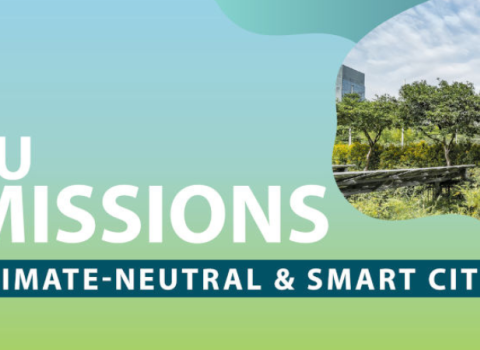The Horizon Europe Missions are facing a wave of criticism. But are the alleged flaws intrinsic to the missions concept, or are they the result of missteps in implementation that can be resolved? I believe it is the latter

Iacopo Gronchi is a policy expert at Demos Helsinki and PhD candidate at the University College London Institute for Innovation and Public Purpose.
Three years on from the inception of EU Missions, enthusiasm around them seems somehow dimmed – with the cancellation of a potential sixth Mission for the ‘New European Bauhaus’, ambiguous expert reviews, and calls for them to be scrapped in Framework Programme 10 (FP10).
There are three main criticisms. Firstly, the Missions are regarded as uncompetitive because they are failing to align with the EU's aspirations to regain technological and economic parity with the US and China. Second, they are seen as cumbersome, with unwieldy governance structures and a reliance on widely spread Horizon Europe instruments. Third, the Missions are seen as being carried along on a wave of rhetoric, allegedly masking business as usual in the guise of tackling societal woes.
A fourth criticism points to the limited legitimacy Missions have at national and local levels.
As a case in point, take the Mission for reaching net-zero in 100 cities by 2030. In terms of competitiveness, it lacks a strategic roadmap for R&D investment in the technologies this will require. In terms of governance, the Mission outsources most of its day-to-day management to a sprawling consortium of 33 partners. In terms of rhetoric, the Mission is stuck with business as usual Horizon Europe budgeting and monitoring cycles. Finally, in terms of legitimacy, this Mission of its nature requires local action, yet it leaves doubts about the ability and will of local actors to seize it not as ‘another EU project' but as a key pillar of their political agendas.
When it comes to passing judgement on the EU Missions, these criticisms deserve consideration. But the crux of the argument remains elusive: are these flaws intrinsic to Missions as a policy approach, or grounded in manageable implementation challenges? Here I claim it is the latter.
Reframing the critique
Missions are more a statement of an ambitious political objective than a clear policy blueprint. Amidst socio-technical, geopolitical, and environmental shifts, no one across the political spectrum contests the need for the Commission to be proactive in ensuring the wellbeing of Europeans. While research and innovation funding remains key to this, we know that classic policy tools alone will not generate the fair and sustainable goals we aim for. Governments have recognised the need for a new approach and there are over 80 ‘net-zero missions’ underway across 20 OECD countries. As these illustrate, there is no one-size-fits-all approach to Missions, beyond the reality that they require more effort than standard research and innovation.
The lack of a ready-made Mission implementation strategy should be balanced against the major progress achieved by the Commission in envisioning and executing a new way of working in just three years. This has involved setting up new governance structures, championing unforeseen levels of research and innovation societal engagement, laying foundations for future achievements – all while work is in progress. This backdrop helps us understand the need for EU Missions to grow out of continuous improvement, as the Commission said last June.
Given this context, we should reframe the question of whether EU Missions work (which I think is a premature and unfair one to pose at this time) with another question: what it would take for the EU to achieve its Missions? Should the Commission address the alleged flaws of the Cities Mission, the rich landscape of mission-oriented initiatives now underway offer plenty of inspiration to do so.
Enhancing competitiveness may entail identifying more granular socio-technical domains to consolidate EU cities' demand for solutions. Streamlining governance may require the strengthening the Commission’s management structures to ensure rapid adaptation in implementation. The lack of novelty charge may be addressed by better integrating Missions within the policy tools, procedures, and resources beyond Horizon Europe – such as the Net Zero Industry Act, Green New Deal, or Important Projects of Common European Interest (IPCEIs). Strengthening the legitimacy of Missions would be possible through stronger engagement with EU, national, and local political leadership. In all these respects, the suggestion of the Danish government to reboot Missions outside of FP10 as high-level legislative acts goes in the right direction.
Unproductive debate
Making a case for better implementation still leaves open the charge that we may be pouring limited resources into fundamentally unachievable tasks. This is clearly reflected in the unproductive debate between ‘mission believers' calling for patience and ‘disbelievers' eager to highlight seemingly inevitable failures.
In this context, the formulation of a theory of change, clarifying how and why a mission is expected to succeed or fail, would help to manage expectations. However, despite the fervour of the debate, engagement with the development of such a theory has been scant. Conversely, it has become hard even to come to a shared definition for what a mission is (not) in the first place. As a result, everyone can argue against or in favour of missions without agreeing on a shared definition first. This does not help either the intellectual or the policy debates move on.
Only recently has the Commission's expert group on monitoring EU Missions articulated a tentative theory of change. With colleagues at Demos Helsinki, we long advocated for experimentalism as a hypothesis for theory of change by pointing out the Missions’ need for agile implementation versus wicked challenges. Without a similar, stronger conceptual anchorage, the debate may perpetuate confusion about the purpose of missions and the conditions under which we can expect them to succeed, or indeed hold them accountable for failure.
To scrap them without doing this would not just neglect EU Missions’ ongoing progress. It would also mean ‘throwing out the baby with the bath water’ and pre-emptively neglecting any possibility of achieving their objective.
No magic wand
In the dichotomy between believers and disbelievers, the purpose of EU Missions risks being obscured. Missions are not magic wands, but they ignite hope in our ability to effect urgent change and reflect constantly on how to realise it. But ambition alone is not enough; humility is also required.
For policymakers and commentators, this means setting aside preconceptions and engaging in a nuanced debate on implementation by developing a proper theory of change and then assessing policy against it. For missions themselves, humility entails a departure from the notion that sticking to the plan alone guarantees success and puts greater focus on the learning mechanisms fostering adaptation against implementation challenges.
By deepening the debate on implementation, believers and disbelievers can chart a shared course to discover how to turn aspirations for EU societal progress from paper to practice. All in all, if the debate catered to the goal of accompanying 100 Cities to net zero by 2030 as much as it does to the ‘M-word’, we’d be better placed by now to grasp how to enable such transformation.
Missions help comfort us that everything’s not lost. Yet, their achievement rests on a delicate balance between audacious ambition and pragmatic humility. We’d better not be so naive as to take their potential for granted – nor so cynical to dismiss it so easily.
Iacopo Gronchi is a policy expert at Demos Helsinki and PhD candidate at the University College London Institute for Innovation and Public Purpose, which is directed by Mariana Mazzucato, the economist who advised the Commission to devise “moonshot” challenges in Horizon Europe. This viewpoint reflects only Gronchi’s personal views and not those of his home institution.





 A unique international forum for public research organisations and companies to connect their external engagement with strategic interests around their R&D system.
A unique international forum for public research organisations and companies to connect their external engagement with strategic interests around their R&D system.